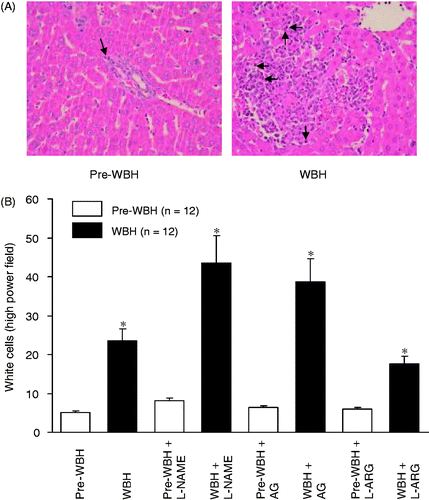Figures & data
Table I. Sequence of PCR primers and TaqMan probes for putative NOS target genes.
Figure 1. A real-time PCR 2.8 ± 0.4, 3.1 ± 0.5 and 3.2 ± 0.8 analysis of eNOS, iNOS and Hsp70 expressions of the liver tissues from the pre-WBH and WBH groups (A). The increases in eNOS, iNOS and Hsp70 mRNA were 2.8 ± 0.4, 3.1 ± 0.5 and 3.2 ± 0.8-fold, respectively (B). There were 12 rats in each group, *p < 0.05, pre-WBH versus WBH. Pre-WBH and WBH denote before and 15 h after whole body hyperthermia. Glyceraldehyde phosphate dehydrogenase (GAPDH) serves as contrast.
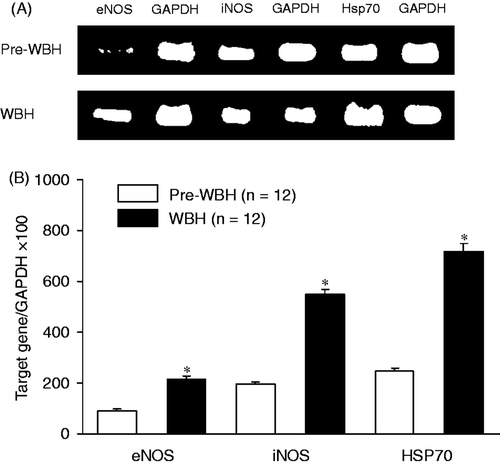
Figure 2. Western blot analysis of the eNOS, iNOS and Hsp70 protein expressions in liver tissues after WBH compared with pre-WBH group. The results indicate significant increases in eNOS, iNOS and Hsp70 expressions (*p < 0.05) in the WBH group. Representative western blot with an immunodetection of eNOS, iNOS and Hsp70 were done using Gene-RL western-blot assay kit (Gene Research, Taiwan). β-actin is an internal standard (n = 12 for each group). The abbreviations are the same as .

Figure 3. Immunohistochemical stain of eNOS (A), iNOS (B) and Hsp70 (C) in pre-WBH and WBH groups. The illustrative micrographs show changes in eNOS, iNOS and Hsp70 activities (arrows) after whole body hyperthermia. The enhancement was 3.1 ± 0.9-fold for eNOS, 10.6 ± 2.6-fold for iNOS, and 6.5 ± 1.4-fold for Hsp70 (*p < 0.05) (D).
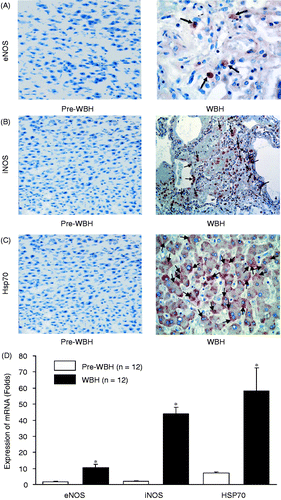
Figure 4. High-performance liquid chromatographic method was used to measure the changes in nitrate/nitrite, the metabolites of nitric oxide, in the pre-WBH and WBH-challenged groups. To evaluate the effects of nitric oxide synthase inhibition, L-NAME and AG were used. Treatment of nitric oxide precursor L-arginine (L-ARG) was also tested. (*p < 0.05, significantly different between pre-WBH and WBH-challenged groups; *p < 0.05, significantly different between pre-WBH versus WBH group with and without nitric oxide inhibitors and precursor, n = 12 for each group). A spectrofluorometer was used to measure methyl guanidine, which represents formation of hydroxyl radicals. The results were similar to those for nitrate/nitrite (*p < 0.05, significantly different between pre-WBH and WBH-challenged groups; *p < 0.01, significantly different between pre-WBH and WBH group with and without nitric oxide inhibitors and precursor, n = 12 for each group).
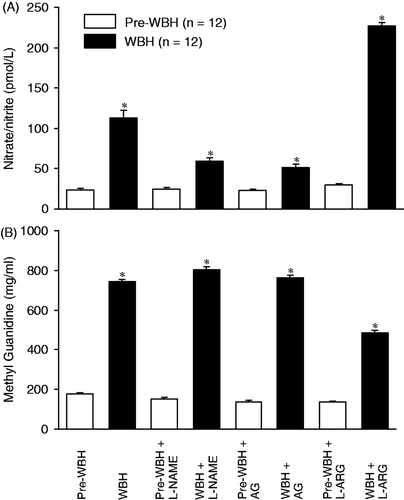
Figure 5. Plasma levels of aspartate aminotransferase (A, AST) and alanine aminotransferase (B, ALT) were measured before and 15 h after exposure to whole body hyperthermia. Significant increase in plasma AST and ALT after exposure to hyperthermia (*p < 0.05) compared with the pre-WBH group. Administration of eNOS and iNOS inhibitors (L-NAME and AG) significantly increased the AST and ALT (*p < 0.001). However, NO precursor, L-ARG attenuated the increase in AST and ALT (*p < 0.05, n = 12 for each group).
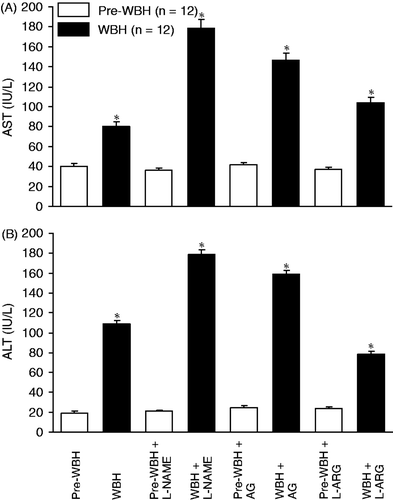
Table II. The liver injury score. The values are means ± SEM (n = 12 in each group).
Figure 6. Western blots of Hsp70 in pre-WBH, WBH and WBH with quercetin (QUE). WBH enhanced the Hsp70 activity (*p < 0.05). Quercetin reduced the Hsp70 activity after WBH (+p < 0.05).
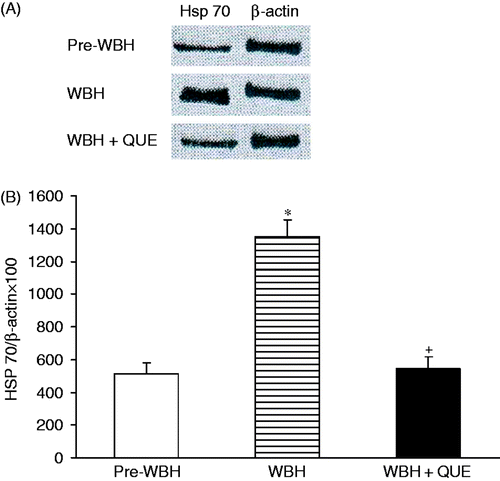
Table III. The plasma NOx (nitrate/nitrite), MG (methyl guanidine), aspartate aminotransferase (AST), alanine aminotransferase (ALT), liver injury score (LIS) and white cell infiltration (WBC) in the sham (pre-WBH) and quercetin (QUE) groups (n = 12 in each group).
Figure 7. A section of liver tissues 15 h after WBH challenge. Inflammation was evidenced by inflammatory cell infiltration with hepatocytes degradation and necrosis (A, arrows). In the pre-WBH group, there were essentially no hepatocyte degradations or necrosis. Panel B shows the white cell count in liver histology under high power field. WBH challenge induced significant white cell sequestration in liver tissues (*p < 0.001). NOS inhibitors aggravated the white cells sequestration (*p < 0.05). However, NO precursor attenuated the cell sequestration (*p < 0.05, n = 12 for each group).
